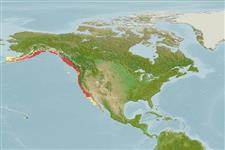Classification / Names
Common names from other countries
Main reference
Size / Weight / Age
Max length : 46.0 cm TL male/unsexed; (Ref. 4925); max. published weight: 810.00 g (Ref. 40637); max. reported age: 86 years (Ref. 56049)
Length at first maturity
Lm 19.0, range 18 - ? cm
Environment
Marine; bathydemersal; depth range 0 - 800 m (Ref. 6793), usually 91 - 579 m (Ref. 2850)
Climate / Range
Deep-water, preferred ?; 60°N - 27°N, 168°W - 109°W
Distribution
Short description
Dorsal
spines
(total): 13;
Dorsal
soft rays
(total): 11-14;
Anal
spines: 3;
Anal
soft rays: 5 - 8;
Vertebrae: 26. Head spines strong - nasal, preocular, postocular, tympanic and parietal spines present, supraocular, coronal and nuchal spines absent (Ref. 27437). Toothed knob in front of each upper jaw, deep notch between jaws (Ref. 27437). Caudal fin moderately indented (Ref. 6885). A red rockfish, silver ventrally (Ref. 27437). Branchiostegal rays: 7 (Ref. 36715).
IUCN Red List Status (Ref. 115185)
Threat to humans
Harmless
Human uses
Fisheries: minor commercial
More information
ReferencesAquacultureAquaculture profileStrainsGeneticsAllele frequenciesHeritabilityDiseasesProcessingMass conversion
Tools
Special reports
Download XML
Internet sources
Estimates of some properties based on models
Phylogenetic diversity index
PD50 = 0.5000 many relatives (e.g. carps) 0.5 - 2.0 few relatives (e.g. lungfishes)
Trophic Level
3.7 ±0.6 se; Based on size and trophs of closest relatives
Resilience
Low, minimum population doubling time 4.5 - 14 years (tm=5; tmax=86; Fec=14,000)
Vulnerability
High to very high vulnerability (66 of 100)
Price category
